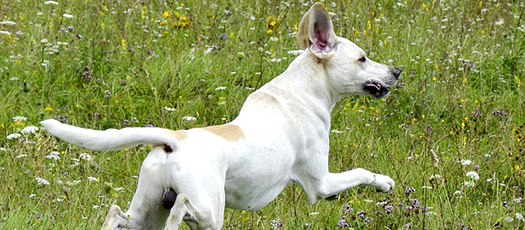
Homeopathic Globules – Little Helpers for Your Doggy Medicine Cabinet
Let’s say your dog has diarrhea or a bladder infection, or is limping after a race with its best friend – you don’t always want to bring out the big guns for minor health problems. Your dog’s small aches and pains can often be quickly and easily remedied with homeopathic treatments.
Here we explain how to use globules to treat your dog at home. Avoid using drops, because they contain alcohol, which many dogs do not like. Choose a potency of D6 or D12. Place five to ten globules inside your dog’s lip as needed. Do not offer any food or treats with them – the ideal way to absorb homeopathic remedies is through the mucous membranes of the mouth. In acute cases, you can repeat the dose every one to two hours. You may see an initial reaction (“initial worsening”) in which some of the symptoms become more pronounced – but overall, the patient should not feel any worse. As the dog’s condition improves, spread out the doses. Once your dog is healthy and symptom-free, it no longer needs to take the globules.
Please note: Consult a veterinarian or animal health practitioner immediately if anything on the following list applies:
- Severe discomfort.
- Body temperature above 39.5 degrees (measured rectally).
- The dog’s general well-being is poor and it is acting apathetic.
- Despite the homeopathy for dogs, symptoms do not improve within 24 hours.
- Chronic illnesses are not suitable for self-medication with homeopathic medicines; an animal homeopath needs to determine the right approach.
- If you are not sure what to do, call a veterinary clinic to discuss the next steps.
Homeopathic globules for your doggy medicine cabinet
Aconitum (blue rocket) – One of the strongest remedies in homeopathy. For complaints that arise very suddenly and are very severe. Perhaps the animal is suffering from shock due to a frightening experience or an accident; aconitum is also indicated as a primary treatment for infectious diseases. The symptoms are: high fever, anxiety and uneasiness, changes in oral mucous membrane color (sometimes red, sometimes pale), and light sensitivity. After taking aconitum, the patient should stabilize fairly quickly. It is often administered as first aid for sudden, severe symptoms until a veterinarian can see the animal.
Apis mellifica (honey bee) – A bee sting causes the symptoms that apis can treat: swelling, redness, and pain. Accordingly, apis is indicated for insect stings and acute inflammations with reddened skin and mucous membranes, e.g. a sore throat or conjunctivitis and puffy eyelids. Apis can also provide relief from the associated allergic reactions with edematous swelling. Important note: if the mucous membrane in the dog’s mouth is swelling up, for instance after a wasp sting, there is a risk of asphyxiation – seek professional help immediately!
Arnica montana (mountain arnica) – Arnica globules are probably the best-known and most important homeopathic first-aid remedy for injuries. Arnica can reduce swelling and bruising after bumps, strains, sprains and other accidents, and it can significantly accelerate healing. Arnica can also help if the animal is worn out from working too hard – a feeling of exhaustion is one of the things listed in its treatment profile.
Arsenicum album (white arsenic) – Arsenicum is typically used for digestive problems after receiving spoiled food or eating snow. Symptoms can include vomiting and terrible-smelling, dark-colored diarrhea, anxiety or panic attacks, and inability to sleep despite exhaustion. The patient frequently drinks small amounts of water and seeks out warm places.
Cantharis (Spanish fly) – Often used as a first-aid remedy for bladder infections. If the animal tries to urinate frequently and can only produce a few drops, if it shows clear signs of discomfort (probably because of a burning sensation), and if it is also nervous and irritable and does not want to be touched, cantharis should provide relief within a few hours. If the dog tries to urinate and is completely unsuccessful, it needs to go to the vet right away!
Euphrasia (eyebright) – Can quickly ease minor eye complaints, such as conjunctivitis. The globules are given internally, of course, in addition to homeopathic eye drops containing the same substance. If you think your dog might have an eye injury, it is better to contact the vet immediately.
Hypericum (St. John’s wort) – Hypericum is used to treat nerve injuries. After operations, contusions, bites, or tooth extractions, it is a good supplement to use with arnica. It can reduce pain and accelerate nerve healing.
Nux vomica (poison nut) – Constipation after overeating often calls for nux vomica globules. This homeopathic remedy can also provide relief for dogs that react badly to medications, and it can support liver detoxification. Nux vomica is also used for sudden, severe back pain, especially if the patient does not want to be touched.
Phosphorus – A newly occurring dry cough calls for phosphorus. This remedy can also stop vomiting. Typically, the dog regurgitates water and food as soon as they grow warm in the stomach, and it exhibits signs of exhaustion.
Podophyllum (mayapple) – Acute, watery diarrhea can be stopped with podophyllum. Excrement shoots out of the anus and is yellowish and tinged with mucous or blood.
Rhus toxicodendron (poison sumac) – This is the first line of defense for motor system problems, for acute or chronic joint inflammation, after overexertion, and for muscle aches. The pain typically abates once the dog is moving. Resting worsens the complaints, so patients often change position while lying down. With chronic arthrosis, symptoms grow worse in cold, wet weather.
In addition to the homeopathic globules, I also recommend the following important medication for your dog’s first-aid kit:
Rescue Remedy globules – The emergency remedy from Bach flower therapy. We are more familiar with them as emergency drops, but the flavorless globules are better suited for dogs. Rescue Remedy is useful in stressful situations of all kinds. It can calm the dog down after a fright or shock, and it can help with grieving, with completing stressful tests, and with processing change.
